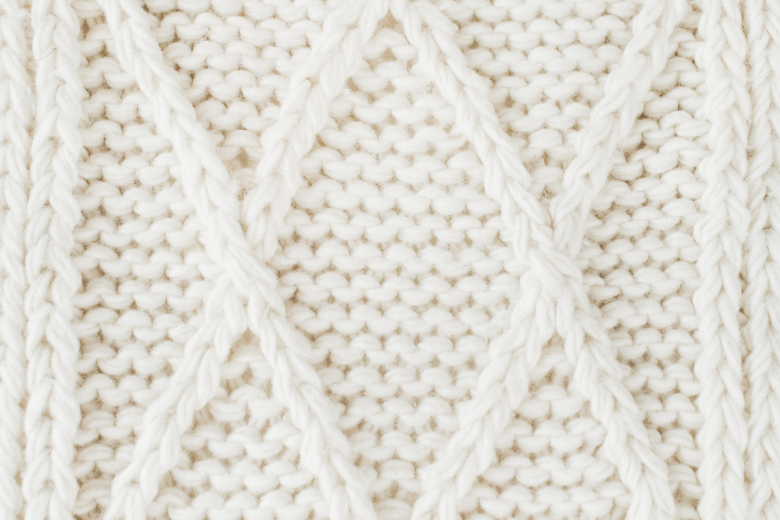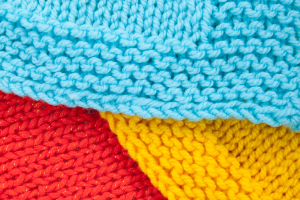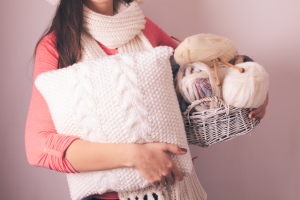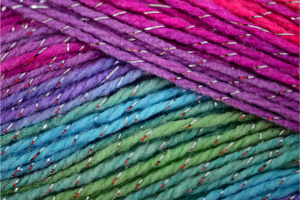The Art of Knitting: Why a Knit Sweater is Perfect for Winter
Knitting has long been a beloved craft, known not only for its creativity but also for its ability to produce cozy, functional garments. When winter rolls around, nothing quite compares to the warmth and comfort of a hand-knitted sweater. Whether you’re a seasoned knitter or a beginner eager to start your first project, creating your own sweater allows you to tailor every detail to your taste while embracing the therapeutic nature of the craft. A knit sweater isn’t just a piece of clothing; it’s a piece of art, carefully woven together with each stitch, providing both warmth and a sense of accomplishment.
Knitting as a Form of Expression: Benefits and Comfort in Winter
Beyond the warmth, knitting offers a unique opportunity for self-expression. Choosing the yarn, the stitch pattern, and the design gives you the chance to craft a sweater that reflects your personal style. Additionally, knitting has a therapeutic effect, helping to reduce stress and anxiety, which is particularly helpful during the colder months when we often feel more isolated. The meditative rhythm of the needles, combined with the satisfaction of creating something by hand, makes knitting not just a hobby, but a mindful practice. When the weather gets chilly, there’s no better feeling than wrapping yourself in a piece of clothing you’ve made yourself, knowing it was crafted with care and intention.
In this guide, we’ll walk you through the process of making the perfect knit sweater for winter, from selecting the right materials to mastering knitting techniques, ensuring that you create something that’s both beautiful and functional.
Knitting has a rich history that spans centuries, and over time, it has evolved from a necessary skill for making clothes to a beloved creative outlet. As winter approaches, the desire for warmth and comfort increases, making a hand-knitted sweater not only a practical choice but also a way to connect with a timeless tradition. Whether you’re looking to create a classic design or experiment with modern patterns, knitting provides the flexibility to craft something truly unique. Each stitch serves as a reminder of the care and effort you put into making something that will keep you warm throughout the cold months.
What makes a knit sweater particularly special is the connection between the maker and the garment. Unlike mass-produced clothing, a hand-knitted sweater is imbued with the personal touch of its creator. From selecting the perfect yarn to choosing the stitch pattern and sizing, every decision is made with intention, resulting in a garment that feels uniquely yours. As you work through each row and stitch, you not only build a beautiful piece of clothing but also develop a deeper appreciation for the art of knitting itself.
Knitting also encourages mindfulness, allowing you to slow down and focus on the task at hand. In a world that is often fast-paced and hectic, the rhythmic motion of knitting provides a sense of calm and an opportunity to disconnect from the stresses of daily life. This is especially valuable during winter, a time when many people experience seasonal stress and a longing for comfort. A handmade sweater, therefore, becomes more than just a practical item; it becomes a symbol of self-care and creativity.
Choosing the Right Material for Your Knit Sweater
The material you choose for your knit sweater is critical to its comfort, durability, and warmth. Wool is a popular choice due to its natural insulating properties and softness, but there are other options available depending on your needs. Merino wool is fine and luxurious, making it perfect for those with sensitive skin, while alpaca yarn is incredibly warm and lightweight. Cotton is a good option for milder winters, offering breathability and comfort, though it lacks the warmth of wool. Acrylic and blended yarns are often chosen for their affordability, wide range of colors, and ease of care. When selecting yarn, consider factors like texture, weight, and how easy it is to care for.
How to Choose the Color and Style of Your Knit Sweater
Selecting the right color and style of your knit sweater is where your creativity can shine. Think about the colors that will complement your wardrobe and how the sweater will fit into your everyday outfits. For a versatile piece, neutral tones like gray, navy, or beige are timeless and can be paired with nearly anything. If you’re looking to make a bold statement, vibrant colors or multi-tonal yarns can give your sweater a unique look. As for the style, consider whether you want a fitted or loose sweater, long sleeves or short, and whether you prefer a classic crew neck or a more contemporary turtleneck. The style should not only reflect your personal taste but also be practical for the cold weather.
Tools and Equipment Needed for Knitting
To begin knitting your sweater, you’ll need a few essential tools. The most obvious is a set of knitting needles, which come in a variety of materials including bamboo, metal, and plastic. Choose the size that corresponds to your yarn weight and the pattern you’re following. Circular needles are often preferred for knitting sweaters, as they allow for easier handling of large amounts of fabric. In addition to needles, you’ll need a stitch marker to help keep track of your rows and a tapestry needle for weaving in ends once your sweater is completed. A measuring tape is also essential for checking your gauge and making sure your sweater fits as you go.
Step-by-Step Guide to Starting Your Knit Sweater
Starting a knit sweater might seem intimidating, but breaking it down into manageable steps makes it much easier. First, you’ll want to cast on the correct number of stitches for the pattern you’re following. This creates the foundation for your sweater. After casting on, begin knitting according to your chosen pattern, following the instructions for ribbing, body sections, and sleeves. Many sweaters are knit in pieces (front, back, and sleeves), which are then sewn together, while others are knit in the round in a seamless design. Don’t be afraid to take your time—knitting is a slow process, but it’s meant to be enjoyed.
How to Read a Knitting Chart or Pattern
Understanding knitting charts and patterns is key to successfully completing your sweater. A knitting pattern is a set of written instructions that explain how to create the design, including stitch patterns, shaping, and finishing techniques. A chart, on the other hand, visually represents the stitch pattern and is often used for more complex designs. Each square on the chart corresponds to a stitch, and the directions guide you row by row. If you’re new to reading charts, start with simple patterns before progressing to more intricate designs. Ensure you understand the abbreviations used and don’t hesitate to look up terms or techniques online for clarity.
Basic and Advanced Knitting Techniques for Sweaters
As you work on your sweater, you’ll encounter both basic and advanced knitting techniques. Basic techniques include knit and purl stitches, which form the foundation of most patterns. As you advance, you may use techniques like cables, lacework, or colorwork, which add texture and visual interest to your sweater. Learning to knit in the round, for example, eliminates the need for seams and allows for a smoother finish. Advanced techniques like short rows can be used to shape the sweater for a more fitted look, while increasing and decreasing stitches will help create the correct size and form.
How to Achieve the Perfect Fit: Measuring and Adjusting the Size
Achieving the perfect fit is one of the most important aspects of knitting a sweater. To ensure the right size, start by taking accurate measurements of your bust, waist, and hips, as well as the length of the sleeves and body. Once you’ve chosen your pattern, check the gauge by knitting a small swatch. This ensures that the stitches per inch match the pattern’s requirements. If the gauge is off, you can adjust by changing the needle size or the yarn thickness. As you knit, try on the sweater at different stages to ensure it fits properly and make any necessary adjustments along the way.
Tips for Finishing Your Sweater with Impeccable Edges
Finishing touches are essential for a professional-looking sweater. Once you’ve completed the body and sleeves, it’s time to sew the pieces together. Use a mattress stitch for seams to create a seamless look. After assembling your sweater, weave in any loose ends with a tapestry needle. If your pattern calls for cuffs, necklines, or hems, these can be finished with ribbing or other decorative borders. Block your sweater to help set the stitches, smooth out any uneven areas, and ensure it has the proper shape. A neat, tidy finish will give your sweater a polished look and make it look professionally made.
How to Wash and Care for Your Knit Sweater for Longevity
Proper care is essential to ensuring that your knitted sweater lasts for many winters. Always follow the care instructions on your yarn label, as different fibers require different handling. Wool, for example, should typically be hand-washed or machine-washed on a gentle cycle in cold water to prevent felting. After washing, lay the sweater flat to dry, reshaping it to its original dimensions. Store your sweater in a cool, dry place to avoid any damage from heat or humidity. Regular care and gentle washing will keep your sweater looking fresh and extend its lifespan, allowing you to enjoy it for years to come.
These tips will guide you in creating a beautiful, comfortable knit sweater that’s tailored to your personal style and functional for the winter season.
The Knit Sweater: A Gratifying and Sustainable Project for Winter
Knitting your own sweater is more than just a crafting project—it’s an opportunity to create something that is both functional and deeply personal. Not only will you enjoy the satisfaction of making a piece of clothing from scratch, but you’ll also be contributing to sustainability. By choosing eco-friendly materials, you can ensure that your sweater is as kind to the environment as it is to your skin. Moreover, a hand-knitted sweater, with its unique design and thoughtful craftsmanship, is something that can last for years, unlike fast-fashion alternatives. It’s an investment in quality, creativity, and the timeless joy of handmade creations.
As you wear your knit sweater, you’ll feel a sense of pride knowing it was crafted with care and love. It’s a testament to the art of knitting, a craft that connects generations and cultures, and a reminder that even in the colder months, there’s warmth not only in the yarn but in the process of making something with your own hands.
Final Tips for Ensuring a Perfect Knit Sweater
To ensure your knit sweater turns out perfect, pay attention to the details from start to finish. Make sure to check your gauge regularly and don’t rush the process—take your time with each stitch, as every little effort contributes to the final product. Don’t hesitate to try your sweater on as you go to make adjustments to the fit, ensuring it’s exactly what you envisioned.
If you’re new to knitting, remember that perfection comes with practice. Don’t be discouraged by mistakes; instead, view them as learning opportunities. Use them to improve and refine your skills. And, most importantly, enjoy the process—knitting is a relaxing and rewarding hobby that offers both creative satisfaction and practical benefits.
Lastly, when you finish your sweater, give it the care it deserves. Proper washing, storage, and maintenance will ensure your hand-knitted masterpiece lasts for many winters to come. With these tips, you’ll not only have a beautiful sweater but also a meaningful, sustainable piece that you can cherish for years ahead.
The beauty of knitting your own sweater lies in the connection between the maker and the garment. Each time you wear it, you are reminded of the care, patience, and creativity that went into crafting it. Unlike store-bought items, which often lack individuality, your hand-knitted sweater becomes a reflection of your personal style and your dedication to the craft. It’s not just a sweater; it’s a work of art that tells the story of the time you spent weaving together yarn, stitch by stitch, to create something that is truly one-of-a-kind.
Additionally, knitting offers a wonderful sense of accomplishment that goes beyond the final product. The process itself can be deeply satisfying—watching a piece of yarn transform into a beautiful, wearable garment is incredibly rewarding. This feeling of achievement is further amplified by the knowledge that you have created something that will be both functional and lasting, a testament to your skills and commitment.
Furthermore, knitting encourages sustainability, as it enables you to make something long-lasting and avoid the environmental impact of mass-produced clothing. By selecting high-quality, eco-friendly yarns and thoughtfully crafting a piece that will stand the test of time, you are actively making a positive choice for the planet. Hand-knitted garments are less likely to end up in landfills, making them a far more responsible choice than fast-fashion alternatives that contribute to waste and pollution.
In the end, the joy of knitting your own sweater lies not only in the finished product but also in the process of creating it. From the moment you cast on the first stitch to the final fitting, every part of the project offers a chance to slow down, focus, and enjoy the art of making. And when you finally pull on your cozy sweater, you’ll feel the warmth not only from the yarn but from the sense of pride in your craftsmanship and the knowledge that you’ve created something truly special.




